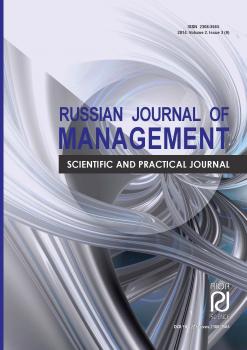VAK Russia 5.2.3
VAK Russia 5.2.4
VAK Russia 5.2.5
VAK Russia 5.2.6
VAK Russia 5.2.7
UDC 338.47
The article examines the impact of transport infrastructure development on regional economic growth in Russia. The transport sector plays a key role in ensuring labor mobility, improving the efficiency of logistics processes, enhancing the investment attractiveness of territories, and reducing spatial disparities. However, the extent of its influence on regional economic development is uneven and largely depends on the socio-economic conditions of each territory. The analysis is based on panel data covering 82 Russian regions for the period 2015–2022. To obtain robust estimates, the generalized method of moments (GMM) was applied, which makes it possible to account for variable endogeneity and the dynamic nature of the processes under study. The findings demonstrate that, at the national level, the influence of transport infrastructure on economic growth is statistically insignificant, which can be explained by the spatial heterogeneity of its effects. In more developed regions, the qualitative characteristics of the transport network have a positive impact on GRP growth, while in remote and less developed territories, the effect is constrained by external factors such as low population density and weak investment activity.
transport infrastructure, socio-economic development, economic growth, generalized method of moments (GMM), panel data, regional inequality
Введение. Формирование и реализация региональной экономической политики предполагает обязательный учет инфраструктурных ресурсов региона для обеспечения социально-экономического развития, снижения территориальных дисбалансов и повышения инвестиционной привлекательности регионов. Важнейшую роль в этом контексте занимает транспортная инфраструктура, поскольку ее качество напрямую влияет на эффективность логистических процессов, мобильность рабочей силы и доступность различных рынков. Таким образом, одной из ключевых задач региональной политики является анализ того, как различные характеристики транспортной инфраструктуры отражаются на показателях развития региона.
Одновременно с этим, научные исследования, посвященные оценке вклада транспортной инфраструктуры в экономику российских регионов, остаются ограниченными и не дают однозначного ответа о наличии статистически значимого воздействия. Так, значительное количество исследователей отмечает наличие взаимосвязи между развитием транспортной инфраструктуры и уровнем социально-экономического развития регионов и государства в целом [1, 2, 3]. При этом существующие работы подчеркивают, что развитие автомобильных и железнодорожных дорог способствует формированию производственных кластеров, отраслевой специализации и повышению конкурентоспособности на уровне национальной экономики в целом [4].
В то же время для регионального уровня результаты могут быть менее однозначными – влияние транспортной инфраструктуры может существенно различаться в зависимости от территориальных особенностей каждого конкретного региона. В этой связи важно учитывать пространственные внешние эффекты, которые создаются транспортными системами, а их количественная оценка необходима для принятия обоснованных решений о механизмах и источниках финансирования развития инфраструктуры.
Цель исследования – анализ вклада региональной транспортной инфраструктуры в экономический рост субъектов Российской Федерации, а также проверка гипотезы о существовании её влияния на обеспечение регионального экономического развития.
Материалы и методы исследования. Для проведения необходимой оценки с помощью программы Stata 13 была сформирована панельная регрессионная модель, охватывающая показатели работы транспортных систем российских регионов и их макроэкономические факторы в динамике, рассчитанные на основании данных Росстата [5].
Результаты исследования и их обсуждение. В качестве зависимой переменной, отражающей уровень экономического развития регионов, выбран рост валового регионального продукта (ВРП) на душу населения. Этот показатель объединяет ключевые макроэкономические индикаторы состояния экономики региона, включая доходы населения, бюджетные поступления, прибыль предприятий и другие показатели, и фактически выступает интегральной мерой регионального экономического развития.
В качестве независимых переменных были использованы две группы показателей для 82 российских регионов за период с 2015 по 2022 годы. Первая группа включает параметры, напрямую характеризующие функционирование транспортной системы, вторая – макроэкономические показатели региона, отражающие его специфические экономические условия. Основная цель исследования состоит в интеграции транспортной инфраструктуры в модель регионального экономического роста и оценке направленности ее влияния на основе эмпирических данных.
К первой группе показателей относятся:
- перевезенные грузы автотранспортом на душу населения за год (CAaw);
- перевезенные пассажиры авто- и ж/д-транспортом на душу населения за год (PASS);
- удельный вес автомобильных дорог с твердым покрытием в дорожной сети региона (AW), удельный вес автомобильных дорог с усовершенствованным покрытием в дорожной сети региона с твердым покрытием;
- коэффициент Энгеля отдельно для автодорог (ENaw) и ж/д путей (ENhw), который характеризует плотность размещения транспортной инфраструктуры на территории региона, и рассчитанный в соответствии с формулой 1:
(1)
где 
 – протяженность транспортных путей
– протяженность транспортных путей 
 -того региона;
-того региона;

 – площадь
– площадь 
 -того региона;
-того региона;
– численность населения 
 -того региона в период
-того региона в период 
 .
.
Кроме того, для отдельных регрессионных моделей на основе коэффициента Энгеля был рассчитан показатель, который позволяет учесть «экономический» размер региона, включив в формулу показатель ВРП на душу населения – формула 2.
(2)
где – номинальный ВРП на душу населения 
 -того региона в период
-того региона в период 
 .
.
Использование ВРП на душу населения в подобной модели позволяет косвенно учитывать степень эксплуатации транспортной инфраструктуры, поскольку интенсивность экономической активности тесно связана с нагрузкой на транспортные сети. Это воздействие отражается не только на темпах развития конкретного региона, но и на транспортной доступности соседних территорий. Таким образом, данный показатель частично отображает проблему перегрузки транспортной системы, когда пропускная способность существующей инфраструктуры становится ограничивающим фактором экономического роста [6].
В связи с этим в исследовании рассматриваются два подхода к построению модели: первый вариант предполагает использование классического коэффициента Энгеля, а второй – применение модифицированной версии коэффициента, которая учитывает ВРП на душу населения.
Во вторую группу переменных, включенных в модель, входят показатели роста индекса потребительских цен (ИПЦ) в регионе (INF), уровень безработицы (UNEMP) и инвестиции в основной капитал на душу населения (INV). Эти показатели необходимы для корректного отражения специфики региональной экономики, так как они описывают общую социально-экономическую ситуацию, которая может существенно влиять на динамику ВРП независимо от состояния транспортной инфраструктуры.
Таким образом, модель примет следующий вид – формула 3:
или
(3)
где – рост ВРП на душу населения;
– показатели работы транспортной инфраструктуры в регионе;
– макроэкономические показатели региона;

 – показатели специфики региона, не учтенные в модели;
– показатели специфики региона, не учтенные в модели;
– случайная ошибка модели.
Характеристика используемых переменных приведена в таблице 1.
В первую очередь, необходимо определить характер связи между переменными – для этого рассчитаем корреляционную матрицу на основе коэффициента Пирсона – формула 4.
(4)
где 
 – значение объясняющей переменной в
– значение объясняющей переменной в 
 -том периоде;
-том периоде;

 – значение объясняемой переменной в
– значение объясняемой переменной в 
 -том периоде.
-том периоде.
Таблица 1
Характеристика переменных в регрессионной модели
|
Переменная |
Количество наблюдений |
Средняя величина |
Стандартное отклонение |
Минимум |
Максимум |
|
GDPgrowth |
738 |
0,11 |
0,10 |
-0,19 |
0,76 |
|
ENhw |
738 |
0,30 |
0,17 |
0,00 |
0,72 |
|
ENaw |
738 |
0,42 |
0,21 |
0,03 |
1,00 |
|
CAaw |
738 |
13,71 |
11,40 |
0,33 |
103,55 |
|
PASS |
738 |
67,23 |
30,09 |
4,48 |
176,28 |
|
AW |
738 |
71,91 |
14,05 |
30,40 |
100,00 |
|
AWquality |
738 |
61,59 |
20,58 |
5,83 |
99,85 |
|
UNEMP |
738 |
6,24 |
3,85 |
0,00 |
32,30 |
|
INF |
738 |
0,07 |
4,36 |
101,10 |
142,50 |
|
INV |
738 |
119,4 |
128,05 |
8,8 |
1 699,9 |
Источник: составлено по данным Росстата [4]
Коэффициент корреляции принимает значения в диапазоне от -1 до 1, при этом чем ближе показатель к одному из этих значений, тем сильнее линейная связь между рассматриваемыми переменными - в данном случае между ростом ВРП на душу населения и характеристиками транспортной системы, а также макроэкономическими факторами. Проведение корреляционного анализа важно прежде всего для выявления взаимозависимых переменных и минимизации риска мультиколлинеарности.
Результаты анализа представлены в виде корреляционной матрицы в таблице 2. Поскольку сильной корреляционной зависимости в соответствии со шкалой Чеддока (0,7 - 0,9) выявлено не было, исключения переменных для нивелирования эффекта мультиколлинеарности из модели не требуется.
Таблица 2
Корреляционная матрица переменных
|
|
GDPgrowth |
ENhw |
ENaw |
CAaw |
PASS |
AW |
AWquality |
UNEMP |
INF |
INV |
|
GDPgrowth |
1 |
|||||||||
|
ENhw |
-0,034 |
1 |
||||||||
|
ENaw |
-0,084 |
0,384 |
1 |
|||||||
|
CAaw |
-0,024 |
-0,012 |
-0,298 |
1 |
||||||
|
PASS |
-0,029 |
0,052 |
-0,116 |
0,069 |
1 |
|||||
|
AW |
0,069 |
0,020 |
0,085 |
-0,095 |
0,052 |
1 |
||||
|
AWquality |
-0,007 |
0,297 |
0,280 |
-0,133 |
0,260 |
0,018 |
1 |
|||
|
UNEMP |
-0,106 |
-0,325 |
0,077 |
-0,152 |
-0,344 |
-0,094 |
-0,327 |
1 |
||
|
INF |
0,230 |
0,028 |
0,051 |
-0,006 |
-0,019 |
0,048 |
0,054 |
-0,048 |
1 |
|
|
INV |
0,091 |
-0,168 |
-0,438 |
0,353 |
-0,030 |
-0,031 |
-0,199 |
-0,211 |
-0,045 |
1 |
Для оценки результатов модели будет применен метод обобщенных моментов (GMM) к динамическим панельным данным. Выбор этого метода обусловлен необходимостью корректного учета как неизменяемых индивидуальных характеристик регионов (фиксированных эффектов), так и возможной эндогенности зависимой переменной. Так, уровень развития транспортной инфраструктуры может оказывать влияние на экономический рост, при этом одновременно находясь под его воздействием, что создает проблему обратной причинности [7]. Метод GMM позволяет использовать лаги переменных в качестве инструментальных, обеспечивая тем самым устойчивые и несмещенные оценки [8]. Кроме того, включение лага зависимой переменной в модель требует использование динамического подхода, что делает GMM более предпочтительным по сравнению с традиционными методами, такими как метод наименьших квадратов [9].
В модели единственной эндогенной переменной выступает значение роста ВРП на душу населения за предыдущий период (GDPgrowth.L1). Таким образом, построенная модель учитывает как институциональные и экономические различия между регионами, так и возможную взаимную обусловленность зависимой и независимых переменных.
Результаты регрессионного анализа для всех 82 субъектов РФ представлены в таблице 3. Анализ показывает, что, за исключением макроэкономических показателей, все коэффициенты оказались статистически незначимыми, что указывает на отсутствие существенного влияния транспортной инфраструктуры на экономический рост регионов в масштабах всей страны. Для проверки корректности полученных оценок были проведены два теста: Хансена (J-тест) для оценки экзогенности используемых инструментальных переменных и тест Арельяно-Бонда (AR2) для выявления автокорреляции случайных ошибок второго порядка. Результаты этих тестов для каждой модели подтверждают корректность проведенных оценок.
Таблица 3
GMM-оценки для панельных данных (82 субъекта РФ), 2015-2022 гг.
|
Переменные |
Вариант 1 |
Вариант 2 |
||
|
Коэффициент |
p-значение |
Коэффициент |
p-значение |
|
|
GDPgrowth.L1 |
-0,47 |
0,00* |
-0,47 |
0,00* |
|
ENhw |
0,62 |
0,55 |
0,93 |
0,86 |
|
ENaw |
-0,59 |
0,59 |
-3,84 |
0,45 |
|
CAaw |
-0,03 |
0,18 |
-0,02 |
0,14 |
|
PASS |
0,00 |
0,73 |
0,00 |
0,69 |
|
AW |
-0,01 |
0,30 |
-0,01 |
0,28 |
|
AWquality |
-0,01 |
0,50 |
0,00 |
0,77 |
|
UNEMP |
-0,04 |
0,00* |
-0,03 |
0,00* |
|
INF |
0,01 |
0,01* |
0,01 |
0,00* |
|
INV |
0,00 |
0,15 |
0,00 |
0,09*** |
|
Остатки |
1,52 |
0,24 |
1,42 |
0,18 |
|
AR(2) |
0,339 |
0,107 |
||
|
Hansen |
0,001 |
0,002 |
||
При этом при добавлении в модель группировки по федеральным округам результаты существенно меняются. Так, при анализе относительно богатого Северо-Западного федерального округа показатели качества транспортной инфраструктуры становятся статистически значимыми (включая коэффициенты Энгеля для автомобильных и железных дорог, а также долю дорог с твердым и улучшенным покрытием) – таблица 4. Для варианта модели с использованием стандартного коэффициента Энгеля все значимые коэффициенты имеют положительное значение, что указывает на положительное влияние качества транспортной инфраструктуры на экономический рост в более развитых регионах.
Таблица 4
GMM-оценки для панельных данных СЗФО
|
Переменные |
СЗФО |
|||
|
Вариант 1 |
Вариант 2 |
|||
|
Коэффициент |
p-значение |
Коэффициент |
p-значение |
|
|
GDPgrowth.L1 |
0,07 |
0,03** |
-1,18 |
0,07*** |
|
ENhw |
0,193 |
0,032** |
5,68 |
0,90 |
|
ENaw |
0,141 |
0,08*** |
-79,88 |
0,34 |
|
CAaw |
-0,01 |
0,73 |
-0,01 |
0,70 |
|
PASS |
0,00 |
0,92 |
0,00 |
0,99 |
|
AW |
0,57 |
0,05** |
0,05 |
0,45 |
|
AWquality |
0,27 |
0,023** |
0,01 |
0,92 |
|
UNEMP |
-0,15 |
0,14 |
0,04 |
0,75 |
|
INF |
0,03 |
0,06 |
0,01 |
0,17 |
|
INV |
0,00 |
0,043** |
0,00 |
0,34 |
|
Остатки |
0,00 |
0,00 |
0,00 |
0,00 |
При рассмотрении аналогичных показателей для менее обеспеченных регионов, традиционно сталкивающихся с проблемами транспортной инфраструктуры (например, Дальневосточного федерального округа - таблица 5), результаты модели изменяются, а влияние транспортной инфраструктуры на экономический рост становится незначительным. Даже те транспортные показатели, которые оказывают статистически значимое воздействие – например, объем перевезенных грузов на душу населения во втором варианте модели, демонстрируют отрицательный эффект на рост ВРП. Такой результат может быть связан с преобладанием локальной, а не сетевой транспортной инфраструктуры.
Таблица 5
GMM-оценки для панельных данных ДФО
|
Переменные |
ДФО |
|||
|
Вариант 1 |
Вариант 2 |
|||
|
Коэффициент |
p-значение |
Коэффициент |
p-значение |
|
|
GDPgrowth.L1 |
0,00 |
1,00 |
-0,18 |
0,76 |
|
ENhw |
0,73 |
0,27 |
0,39 |
0,60 |
|
ENaw |
-0,13 |
0,30 |
-0,20 |
0,30 |
|
CAaw |
0,04 |
0,41 |
-0,02 |
0,042** |
|
PASS |
0,02 |
0,24 |
0,00 |
0,96 |
|
AW |
0,69 |
0,14 |
0,08 |
0,07 |
|
AWquality |
0,08 |
0,42 |
-0,13 |
0,53 |
|
UNEMP |
-0,13 |
0,38 |
-0,12 |
0,076*** |
|
INF |
0,00 |
0,88 |
0,01 |
0,12 |
|
INV |
0,00 |
0,065*** |
0,00 |
0,34 |
|
Остатки |
-50,62 |
0,10 |
1,23 |
0,92 |
Хотя в рамках данной работы не учитывалось взаимодействие элементов транспортной системы между собой, схожие исследования показывают, что регионы с активным развитием автомобильной сети обычно демонстрируют более высокие темпы роста ВРП на душу населения, что способствует более эффективному использованию трудовых и капитальных ресурсов [6].
В целом результаты регрессионного анализа подчеркивают существующие различия между российскими регионами и показывают, что влияние транспортной инфраструктуры на экономическое развитие существенно зависит от изначального уровня социально-экономического развития территории. Так, относительно обеспеченные регионы получают преимущества от уже развитой транспортной сети, что способствует ускорению экономического роста по сравнению с общероссийскими показателями. При этом, как показал пример Северо-Западного федерального округа, значение имеют не столько количественные показатели транспортной системы, сколько ее качество и масштабы (например, доля дорог с твердым покрытием и плотность инфраструктуры). Данные результаты подтверждают гипотезу о высокой отдаче от инфраструктурных инвестиций в экономически активных регионах.
Для менее развитых и отдаленных территорий, таких как регионы Дальневосточного федерального округа, транспортная инфраструктура не оказывает заметного влияния на темпы экономического роста, а в некоторых случаях ее влияние может быть негативным, что может объясняться доминированием других ограничивающих факторов, таких как низкая плотность населения, слабая инвестиционная активность, высокие логистические издержки и отсутствие производственной кластеризации. Таким образом, эффективность транспортной инфраструктуры зависит не только от её наличия, но и от экономического контекста региона.
Важно отметить, что средние показатели роста ВРП на душу населения по федеральным округам в анализируемый период находятся на схожем уровне – примерно 11% в год (в номинальных ценах, без учета инфляции) [5]. Это указывает на то, что для «богатых» регионов транспортная инфраструктура выступает необходимой основой для экономического развития. По мере экономического роста бедных регионов, где на данный момент транспортная инфраструктура не оказывает значимого влияния, ее развитие будет становиться все более актуальным и важным для стимулирования экономического роста.
Результаты анализа также показывают, что в рамках регрессионной модели для всех субъектов Российской Федерации влияние транспортной инфраструктуры в целом является статистически незначимым, что, вероятно, связано с высокой пространственной неоднородностью ее эффектов. Это подчеркивает важность не только корректного построения эконометрической модели, но и учета территориальных различий при анализе.
Кроме того, полученные значения коэффициентов для макроэкономических переменных подтверждают, что такие факторы, как уровень безработицы и инфляция, существенно влияют на региональные различия в темпах экономического роста. В большинстве моделей коэффициент при уровне безработицы оказался статистически значимо отрицательным, что отражает наличие неиспользуемого трудового потенциала, ограничивающего рост в исследуемый период. Эти результаты показывают, что первостепенное значение для регионального развития имеют именно макроэкономические факторы, тогда как транспортная инфраструктура выступает скорее как базовый элемент экономического роста, а ключевое опосредующее влияние оказывает общее состояние региональной и национальной экономики.
Выводы. С учетом полученных данных развитие транспортной инфраструктуры требует комплексного подхода со стороны региональных властей, учитывающего как пространственные факторы, так и специфические особенности территорий. При этом эффективность транспортных объектов, являющихся важной составляющей регионального экономического роста, напрямую зависит от объема финансирования проектов и, соответственно, их инвестиционной привлекательности. Таким образом, формирование механизмов повышения инвестиционной привлекательности объектов региональной транспортной инфраструктуры становится одной из ключевых задач современной региональной экономической политики.
1. Isaev A.G. Gosudarstvennye kapitalovlozheniya kak determinanty ekonomicheskogo rosta rossiyskih regionov // Regionalistika. 2014. №4. URL: https://cyberleninka.ru/article/n/gosudarstvennye-kapitalovlozheniya-kak-determinanty-ekonomicheskogo-rosta-rossiyskih-regionov (data obrascheniya: 15.09.2025). EDN: https://elibrary.ru/TLQDHD
2. Kolomak E.A. Effektivnost' infrastrukturnogo kapitala v Rossii / E.A. Kolomak // Zhurnal Novoy ekonomicheskoy associacii. – 2011. – №10(10). – S.74–93. – EDN NXSUUF.
3. Strategiya sovershenstvovaniya gosudarstvennogo upravleniya razvitiem sel'skih territoriy: monografiya / pod obschey redakciey d.e.n., prof. R.H. Adukova, d.e.n., prof. A.E. Suglobova. – Moskva: Izdatel'sko-torgovaya korporaciya «Dashkov i K°», 2025. – 392 s.
4. Scherbanin Yu.A. Transport i ekonomicheskiy rost: vzaimosvyaz' i vliyanie // Evraziyskaya ekonomicheskaya integraciya. 2011. №3(12). S.65–78.
5. Federal'naya sluzhba gosudarstvennoy statistiki. URL: https://rosstat.gov.ru (data obrascheniya: 15.09.2025).
6. Isaev A.G. Transportnaya infrastruktura i ekonomicheskiy rost: prostranstvennye effekty // Prostranstvennaya ekonomika. 2015. №3. URL: https://cyberleninka.ru/article/n/transportnaya-infrastruktura-i-ekonomicheskiy-rost-prostranstvennye-effekty (data obrascheniya: 15.09.2025). DOI: https://doi.org/10.14530/se.2015.3.057-073; EDN: https://elibrary.ru/VCHKAJ
7. Farhadi M. Transport infrastructure and long-run economic growth in OECD countries // Transportation Research Part A: Policy and Practice. 2015. Vol.74. P.73–90. DOI: https://doi.org/10.1016/j.tra.2015.02.006
8. Chakrabarti S. Can highway development promote employment growth in India? // Transport Policy. 2018. Vol.69. P.1–9. https://doi.org/10.1016/j.tranpol.2018.05.009 (data obrascheniya: 15.09.2025).
9. Ke X., Lin J.Y., Fu C., Wang Y. Transport Infrastructure Development and Economic Growth in China: Recent Evidence from Dynamic Panel System-GMM Analysis // Sustainability. 2020. Vol.12. 5618. https://doi.org/10.3390/su12145618 (data obrascheniya: 15.09.2025). EDN: https://elibrary.ru/ONHMKW














